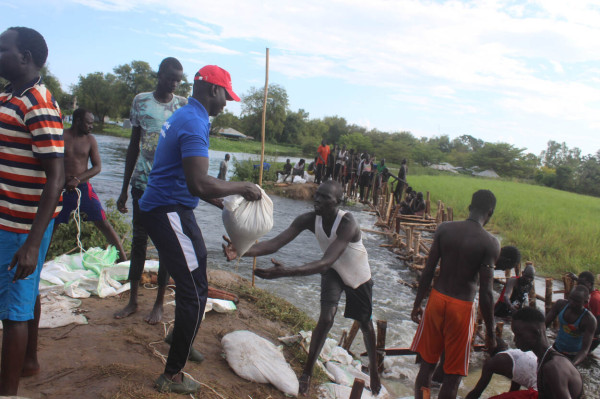Flooding in South Sudan: ‘Simply building dikes is not the solution’

South Sudan is facing the aftermath of its worst floods since 1960. Over 835,000 people have been affected. Working with many partners, the Dutch embassy in Juba is working to bolster climate resilience. How can we minimise the impact of persistent flooding on the people who live there?
‘The climate change that’s been predicted for years is now happening before our very eyes,’ says Richard Aludra, climate specialist at the Dutch embassy in Juba. ‘Average temperatures have been rising since 1980. South Sudan is heating up rapidly, resulting in extreme weather conditions. Periods of drought are followed by heavy rainfall.’ 2021 was the third consecutive year of serious flooding. 835,000 local residents were affected by the rising waters. 200,000 people had to flee their homes and now live in camps.
Climate resilience
The Netherlands contributed emergency aid, such as shelter, basic facilities and medical assistance. However, Bentiu – a city with a population of about 300,000 – is still covered in two metres of water. ‘And we’re just at the end of the dry season now and about to head into the rainy season again from April. We really have to work on climate resilience in South Sudan, so that floods have a less severe impacts on the people who live here,’ says Michiel Smet, water expert at the embassy in Juba.
Dikes also need to be maintained
The solution seems simple: build dikes to control the water. But that is not always the solution, as Michiel knows from first-hand experience. ‘After the floods in 2018, young people mobilised to fill sandbags, but the area still flooded again a year later, despite the dikes. Livestock had destroyed the sandbags in some areas, or dikes had been affected by erosion. You also need to be able to maintain dikes, and protect them. People can learn all sorts of technological solutions to make that possible, but it also has to be financially viable.’ What’s more, South Sudan is struggling with a humanitarian and political crisis.
Rising water levels in the White Nile
Bor is a low-lying city situated at the edge of the marshes along the White Nile. The floods grow worse here every year. According to Michiel, climate change is not the only cause. ‘It can also be attributed to the way people deal with water. Forests are being cut down and overgrazing loosens the topsoil. As a result, the water is no longer retained, flowing away faster and causing an increase in flooding. Neighbouring countries, such as Uganda, are also seeing more rainfall. This causes the water level to rise in Lake Victoria, which forces the hydroelectric dam in Uganda to release large volumes of water. This has led to rising water levels in the White Nile.’
Feasible solutions
The governments of the Netherlands and South Sudan have no formal development cooperation ties. How can the Netherlands make a useful contribution despite that? Richard: ‘We work with the International Organization for Migration (IOM), as well as civil society organisations and local authorities, which are directly accountable to the people. Before we start building dikes, drainage canals and irrigation systems, we jointly investigate the options for an efficient and feasible long-term solution.’
Working with many partners
South Sudan is learning from the water management expertise available in the Netherlands. Engineering firms like Euroconsult Mott MacDonald are giving their input on appropriate responses to flooding in the region. Students at the Dr. John Garang Memorial University of Science and Technology in Bor can apply for a grant to study water management in the Netherlands. The local population contributes ideas through disaster risk reduction groups, organised by the local Flood Management Initiative. ‘Wherever possible, we prioritise nature-based solutions,’ Richard says.
Room for the river
That starts with identifying the region’s natural waterways. According to Richard, ‘It’s crucial not to block these natural watercourses. People are currently building homes in places where water wants to move through during periods of heavy rainfall and flooding. We’re exploring whether people can move to higher ground. It is not only safer for them, but also creates room for the river to follow its natural course when the water rises, so flooding causes less damage.’
Essentially, a smarter approach to spatial planning is needed, and the project team is working to support local authorities in these efforts. For example, when new infrastructure is built, it is important to ensure that roads do not obstruct water drainage. The Netherlands is helping with environmental impact reporting, making it possible to identify how the new plans will affect the surrounding environment.
Climate adaptation
Although the Bor Flood Control Initiative kicked off in 2021, its official launch will be held in March 2022. There is still a lot of work to be done before local residents can be sure of keeping their feet dry. Even so, Richard is cautiously optimistic. Representatives of the South Sudanese Ministry of Environment and Forestry and Ministry of Water Resources and Irrigation will be attending the official opening. ‘Finally, the national government of South Sudan is looking at the consequences of climate change. It’s high time that work began on climate adaptation.’
Distributed by APO Group on behalf of Government of the Netherlands.
Get the latest news delivered straight to your inbox every day of the week. Stay informed with the Guardian’s leading coverage of Nigerian and world news, business, technology and sports.






0 Comments
We will review and take appropriate action.